 |
|

|
 |
TABLE of CONTENTS
 |
'Corridors of Commerce' projects to boost highway capacity, improve freight movement |
By Sue Roe
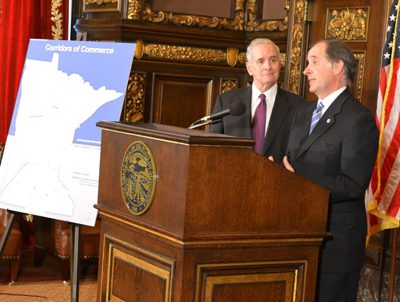
From left: Gov. Mark Dayton and Commissioner Charlie Zelle announce the 10 highway construction projects to receive funding through the Corridors of Commerce program Nov. 14. The selected projects were among more than 400 proposals received. Photo by Sue Roe |
Ten highway construction projects are the first to receive funding through the state’s new $300 million Corridors of Commerce program. Gov. Mark Dayton and MnDOT Commissioner Charlie Zelle announced the projects Nov. 14. The projects will strengthen the state’s transportation system by adding capacity and improving the movement of freight across the state.
“These projects will reduce travel times and improve safety for Minnesota citizens, and help our businesses transport their products more efficiently,” said Dayton. “The number of projects from all over our state, which sought financing from this program, underscores the acute need for more transportation funding.”
Transportation improvements include the addition of lanes, bypasses and shoulders to essential travel corridors in the state, including Interstate 94 between Rogers and St. Michael, Highway 14 in southern Minnesota and Highway 34 between Detroit Lakes and Nevis. The bonding authority is effective July 1, 2014, with five projects scheduled to start in 2014, three in 2015 and two in 2016. Find a map of the projects here.
The selected projects were among more than 400 proposals representing more than 100 unique projects that MnDOT received earlier this fall from public sector partners, stakeholders and interested citizens across the state. Agency staff evaluated eligible projects on selection criteria that included project readiness and deliverability, community support, projected return on investment and safety impacts.
“These projects represent a great first step for the Corridors of Commerce program,” said Zelle. “These critical improvements demonstrate our commitment to providing a commerce-friendly network of freight corridors to ship goods and provide safety and mobility to all users.”
Enacted during the 2013 legislative session, the Corridors of Commerce program authorizes trunk highway bonding to be used for projects that are not already in the state’s four-year State Transportation Improvement Program. The legislation established two major goals for the program: to increase highway capacity on segments where bottlenecks occur and to improve the movement of freight and reduce barriers to commerce.
“There were many good project proposals submitted, indicative of the need and desire to improve Minnesota’s transportation network,” said Zelle. “Unfortunately, we have more projects than money to go around. I’ve been traveling around the state this fall to draw attention to the need for a long-term stable funding source for transportation. My hope is that state and local governments, stakeholders and user groups will join together to address this problem today, to keep our state competitive tomorrow.”
|
 |
|

|
|

|
 |
TABLE of CONTENTS
 |
Complete Streets policy serves all transportation system users |
|
By Sue Roe
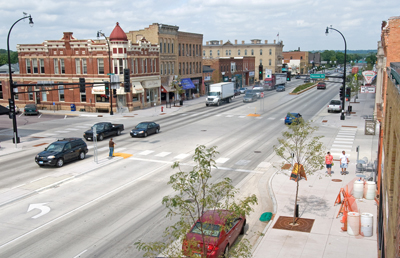
The new Complete Streets policy allows planners and engineers to consider the needs of all users of roadways, including motorists, pedestrians, transit users and vehicles, bicyclists and commercial and emergency vehicles. Photo by David Gonzalez |
When projects and plans are developed and implemented for the state’s trunk highway system, a new “Complete Streets” policy will ensure safe access for all transportation system users.
The policy, approved in November, directs MnDOT planners and engineers to consider the needs of motorists, pedestrians, transit users and vehicles, bicyclists and commercial and emergency vehicles. The policy also recognizes that the needs vary in urban, suburban and rural settings.
“From a design standpoint, this means that all the functions of a project are considered upfront and balanced into a coherent solution,” said Jim Rosenow, MnDOT design flexibility engineer. “The goal is functionality and safety for all users. In the past, the question has typically been ‘why’ to design for anything beyond cars and trucks. The Complete Streets approach means turning that around to ask ‘why not’ instead.”
The policy also provides the framework for achieving MnDOT’s transportation goals, which includes minimizing fatalities and injuries, ensuring economic well-being and quality of life issues, increasing transit use, increasing bicycling and walking and ensuring that all modes of transportation are consistent with the state’s environmental and energy goals.
“Implementing Complete Streets is an important step toward achieving our vision of a multimodal transportation system that maximizes the health of people, the environment and our economy,” said Mark Nelson, Office of Transportation System Management.
In 2010, the State Legislature directed MnDOT to develop a Complete Streets policy. The Office of Environmental Stewardship and the State Aid Division led the effort to create the policy, which resulted in Technical Memorandum 13-17-TS-06 and MnDOT Policy OP004.
The policy addresses transportation solutions in trends the state is facing, such as:
- About 40 percent of Minnesotans do not drive. Complete Streets helps assure everyone has safe access to transportation options to lead active and independent lives.
- Minnesota’s aging population creates a dependence upon several transportation modes. Roads that support biking and walking to community destinations and transit will help an aging population.
- The U.S. population is increasingly concentrated in urban areas and is projected to increase into the future, which will result in increased transportation demand that can be efficiently served through a multimodal transportation system.
- Government agencies are required to bring the transportation system into ADA compliance.
- More Minnesotans are overweight or obese; building infrastructure that supports more walking and biking can help communities create opportunities for people to be more physically active, while improving public health and reducing health care costs.
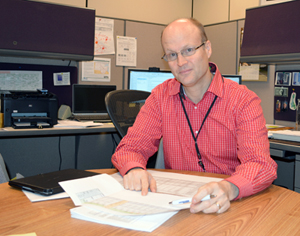
Mark Nelson, Office of Transportation System Management, says the Complete Streets policy is an important step toward achieving MnDOTís vision of a multimodal transportation system that maximizes the health of people, the environment and the economy. Photo by Sue Roe |
With the completion of the new memo and policy, oversight shifts from Environmental Stewardship/State Aid to the offices of Transportation System Management and Project Management & Technical Support. A working group will address implementation issues and meet with each district in December. A separate research implementation effort, led by the University of Minnesota, is now under way to create a guidance document.
Since Complete Streets relies on multi-jurisdictional collaboration, local road authorities are encouraged to adopt a similar policy.
“Complete Streets really operates best at the network level. It’s important to see how the highway network fits in with other modes and not in isolation,” said Nelson.
For questions regarding Complete Streets, please contact Nelson at 651-366-3794 or mark.b.nelson@state.mn.us. Additional information is on MnDOT’s website at: www.mndot.gov/planning/completestreets/. |
 |
|

|
 |
TABLE of CONTENTS
 |
Toward Zero Death Conference is held in St. Cloud |
By Kristin Kammueller
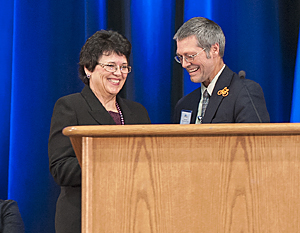
From left: Nelrae Succio, former MnDOT District 6 engineer, receives the Kathy Swanson Outstanding Service Award during the TZD Conference Nov. 14 from Mark Kinde, Minnesota Department of Health. Photo by David Gonzalez |
More than 900 traffic safety advocates from across Minnesota gathered in St. Cloud Nov. 14-15 for the 10th annual statewide Toward Zero Deaths conference.
Gov. Mark Dayton attended the conference and made the opening remarks.
“This tremendous effort by state and local officials and the cooperation of the people of Minnesota show that we can significantly reduce the deaths and destruction on Minnesota’s roads, bridges and highways,” said Dayton. “I thank the members of the Toward Zero Deaths committee for their hard work to reduce crashes and save lives.”
Representatives from the four E’s -- education, engineering, enforcement, and emergency medical and trauma services - learned about a wide range of topics; including how to use information from the recent traffic safety studies, highway responder safety, emerging trends of the drug world and the impaired driver, and how to establish a community safe cab program.
During the first day of the conference the Minnesota TZD Awards were handed out to these recipients:
- Kathy Swanson Outstanding Service Award – Nelrae Succio, former MnDOT District 6 engineer and Jean Ryan, former impaired driving coordinator at DPS Office of Traffic Safety
- Engineering Star Award – Vic Lund, traffic engineer for St. Louis County
- Enforcement Star Award – Sgt. Becky Putzke – recently retired from the Brainerd Police Department
- Judicial/Court Systems Star Award – Thomas Miller, project manager at DPS Bureau of Criminal Apprehension
- Education Star Award – Andrea Gierok, TZD Safe Roads coordinator at Winona County Community Services
- Emergency Medial & Trauma Services Star Award – Tom Vanderwal, program director at Greater Northwest Emergency Medical Services
- Child Passenger Safety Star Award – Esther DeLaCruz, a CPS technical instructor with CPS Associates
- Media Star Award – Jason Manning and KQDS Radio
- Distinguished Public Leadership Star Award – Tom Sorel, CEO of AAA Minneapolis and former MnDOT commissioner
- Special Recognition Award – Real-Time Officer Activity Reporting System (ROAR), in recognition of its innovative and collaborative efforts to improve traffic safety in Minnesota.
For more information about the award recipients or any of the breakout sessions visit www.minnesotatzd.org/events/conference/2013/. |
 |
|

|
 |
TABLE of CONTENTS
 |
Accessibility tips - Part 1: Creating accessible emails |
|
By Becky Dahlberg Making sure workplace communications are accessible for all employees is important to the way we communicate. These accessibility tips will help ensure your communications are accessible to employees with visual impairments who use a screen reader or other assistive devices, and those who use portable devices such as smart phones and tablets. This is the first of a multi-part series on accessibility tips for workplace communications.
Because email is an essential and perhaps unfortunate part of the workplace, and more and more people are composing and reading emails on mobile devices, here are a few tips on how to make emails easily accessible for busy folks on the go.
- Always choose a font that’s easy to read. Same goes for font colors and background choice; the goal is to make your email easily readable with plenty of contrast between font color and background color. Best option: no background color at all. It’s not that your creativity should be limited, but your particular style combinations might not be appreciated or even fully accessible by folks with visual impairments.
- Add basic structure/formatting as needed. Typing an email that’s suddenly turning into a lengthy novel? Go through and reread and delete any unnecessary text, and then add headers for easy skimming. Or better yet, imagine the audience you’re sending it to and highlight the important points for them in bullet format or under a separate header, such as “action items” or the like, so people don’t have to sift through all of the content to prioritize the work.
- Don’t forget a short and sweet subject line, as well as a summary of any important attachments in the body of your email. Ever tried to open an attachment on your smartphone only to get frustrated waiting while it downloaded? Or opened an email at your desk that had no introductory subject line or body text, and an attachment with a vague title or description? You automatically delete it, right? Save your audience some time and guesswork by pulling any important content out of the attachment(s) and into the body of your email - the basic who, what, when, where and why of the attachment. You can still include the attachment for reference or for printing and distribution purposes, but that way people don’t have to click to open it before they even know what they’re opening. Remember, email attachments are not always accessible to folks using assistive technology, so this method will ensure visually impaired people can access the content as well, not to mention save everyone some valuable time and energy.
For more email accessibility guidance, visit http://ihub/communications/ada-resources/email.pdf. Watch for Part 2 in the next issue of Newsline! |
 |
|

|
 |
TABLE of CONTENTS
 |
Bridge Office gathers for annual meeting |
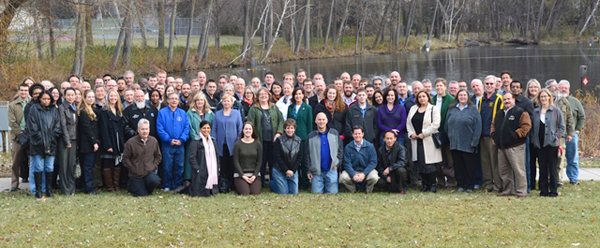
The Bridge Office held their annual meeting Nov. 14 at the Shoreview Community Center. The meeting was emceed by Brandon Day, rotating graduate engineer, and included an office update from Nancy Daubenberger, Bridge Office director, and an overview of the Hwy 52 Lafayette Bridge project by Nick Haltvick, mobility construction engineer. Photo by Becky Dahlberg |
|
 |
|

|
 |
TABLE of CONTENTS
 |
MnDOT employees receive public works awards |
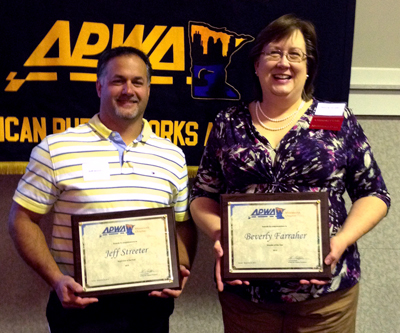
From left: Jeff Streeter and Bev Farraher received awards from the Minnesota Chapter of the American Public Works Association Nov. 21 at the associationís annual conference. Photo by Sheila Johnson |
The Minnesota Chapter of the American Public Works Association honored two MnDOT employees at its annual fall conference Nov. 21 in Brooklyn Center. Outstanding public works employee awards were presented to Jeff Streeter, Golden Valley Traffic Services, and Bev Farraher, Metro District maintenance engineer.
Streeter was chosen as the APWA Minnesota Chapter Supervisor of the Year.
"Jeff has developed from an excellent front line employee to an excellent supervisor who focuses on his crews' safety and production, while simultaneously seeking out improvements and innovation, said Farraher. “He is a pleasure to work with due to his professional and positive attitude. He is a great public servant."
The APWA Personnel Award was awarded to Farraher in the Director Category.
“Bev is always focused on our most important resource, our employees,” said Greg Coughlin, Metro District Office of Operations and Maintenance director. “She continuously strives for safety and technology improvements in our summer and winter maintenance operations. This APWA award, given by her public works peers, recognizes an understanding of her exemplary work, her leadership and commitment to staff and her dedication to public service.”
In addition to the awards program, the conference covered: computers and their application to your utility, implementing a fleet capital equipment program, pavement preservation using Hot-In-Place asphalt recycling, MnDOT bridge maintenance, cable median barrier installation and maintenance, the Vikings stadium design, financing and your crumbling infrastructure, latest requirements and standards for storm water management in Minnesota, multi-modal interchanges, Minnesota Department of Health iron and manganese guidelines and ISME Capstone Projects.
|
 |
|

|
 |
TABLE of CONTENTS
 |
On the Job: Ken Rodgers helps employees with disability issues |
By Sue Roe
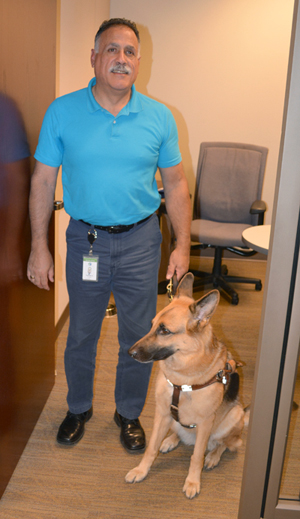
Ken Rodgers, disabilities program coordinator in the Affirmative Action Office, works to protect the rights of employees with disabilities. His guide dog, Havana, works to protect Ken, who has been blind for 17 years. Photo by Sue Roe |
Employees who may have experienced a temporary or permanent health condition affecting their work may have met Ken Rodgers, disability program coordinator. Rodgers helps employees get reasonable accommodations to do their jobs and understand what services the Affirmative Action Office provides.
Rodgers, who came to MnDOT in April, brings a unique perspective to his position. A math and science teacher in California for 12 years, Ken decided to become a registered nurse. He moved to Minnesota for his education and was a cardiac nurse for four years before an eye disease caused him to lose his sight. Still wanting to make an impact, much like what being a teacher and a cardiac nurse did, Rodgers earned his master’s degree in public affairs from the Humphrey School of Public Affairs. His minor was in disability program policy. His teaching and healthcare background, combined with his first-hand knowledge and education of disabilities, are beneficial when he talks with MnDOT employees about health issues.
What does the Affirmative Action Office do?
This is a multi-faceted office that includes anything related to MnDOT’s legal obligations with Affirmative Action. Our efforts ensure we have a diverse and inclusive workforce, objective and impartial investigations regarding discrimination, retaliation or harassing treatment in the workplace, mediation and coaching and training services. We’re also the central connection point for our employee resource groups and the central point for services related to the Americans with Disabilities Act. We also handle reasonable accommodations for employees and ADA access issues.
I work in the Affirmative Action Office with Laurie Steiger, Rosemarie Merrigan, Keith Jacobson, Lynette Geschwind, Janet Miller, Tiesha Bogard and Kristin Jorenby.
What is your area of responsibility as Disability Program Coordinator?
My work ranges from being the point of contact for anyone who needs guidance involving employee and workplace accommodations because of a disability or health condition that is interfering with successful job performance to actually facilitating the interactive process used to develop specific workplace accommodation agreements for employees. I also serve as a resource to employees who may need to explore options or discuss confidential aspects of a new health condition. This is where my experience as a registered nurse comes in as I may be able to explain complex medical concepts in ways they more easily understand.
What types of issues do you deal with?
Some issues are temporary and fairly straight-forward, like helping someone deal with a broken leg. Other conditions can be life-threatening and life-changing, like discovering a disease process that affects all aspects of one’s life. Often these issues are complex and have many facets that require navigation through other programs, like when the Family Leave Medical Act intertwines with their job responsibilities. Then there are the potential issues that arise when an employee feels his or her rights have been trampled upon and/or allege charges of discrimination or harassment or any other violation of MnDOT policy. These all require an impartial and thorough investigation, which can also fall under the umbrella of disability program responsibilities.
What is a typical day like for you?
I deal with such a variety of issues that no two days are alike. One day may start with an employee who has just learned of a new health condition. That might be followed by a phone call from another employee who has tried to deal with health conditions quietly on his or her own but cannot manage that juggling act any longer and doesn’t know what can be done. Wedged into my day are meetings on topics ranging from reviewing existing policies related to some aspect of Affirmative Action or to serve as a representative of MnDOT at various inter-agency events. There just don’t seem to be enough hours at the end of each day.
In what ways have you helped MnDOT be more accessible to the public and its employees?
Because of my own disability and experiences as a blind individual, I am intimately familiar with the challenges and work involved with the accessibility of print materials and web content. I serve as a resource to help ensure other MnDOT departments continue to be vigilant in their endeavors to maintain internal and external print accessibility. This week Newsline begins a series of updates on how employees can make their electronic and print communications more accessible. All employees can do their part by paying attention to these tips.
What is the most rewarding part of your job?
When employees talk to me there often is a great deal of fear and anxiety in their voices. Being able to provide them with clear and concise information as to how the ADA can protect their job or help them set up reasonable accommodation discussions to help overcome obstacles that have emerged because of health conditions often can lift much of the fear and anxiety they are experiencing. That’s rewarding. They leave my office a different person, much more relaxed, empowered and armed with knowledge they didn’t have before.
What is a common misconception about this office?
A common misconception is that this office can’t help the “average, everyday” person. In reality, we offer services and benefits to many employees. Whether it’s an existing health condition or a change in someone’s health, we use ADA as a guideline, but the bigger philosophy at MnDOT is we want our employees to flourish and succeed. If it makes sense, we’ll get an employee what he or she needs if it’s going to help. Everybody wins. There’s often confusion about the word disability and what it means. Most people think disability means severely disabled, and that’s not the case. Bottom line: we help employees get reasonable accommodations so they can be more productive. Everyone is a potential recipient of the services from this office.
What would you like to say about your guide dog, Havana?
Havana has been with me for five years and comes from The Seeing Eye guide dog school in New Jersey. She’s my third guide dog from there and is my eyes, my protector and my buddy. She’s always at my side. When she has her harness on, that means she’s working and is focused on her job and me. She gets me safely around, even in the busiest of places. |
 |
|

|
 |
TABLE of CONTENTS
 |
GIS poster contest winners announced |
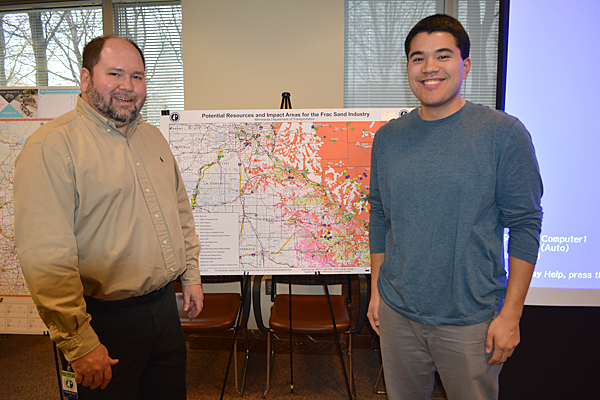
From left: Dan Flatgard, GIS Support, announces David Tomporowski, Office of Transportation System Management, and his team as the first-place entry in the 2013 MnDOT GIS Day Poster Contest Nov. 20. Tomporowski , along with his teammates Patrick Phenow and Dave Christianson from the Office of Freight & Commercial Vehicle Operations and Carol Zoff from the Office of Environmental Stewardship, won this yearís event held in conjunction with National GIS Day. The award-winning entry spotlights the varied cultural and environmental resources that could be affected by frac sand mining. Photo by TK Kramascz |
|
 |
|

|
 |
TABLE of CONTENTS
 |
Whatís new on the web |
By Becky Dahlberg
Land Management
Ever wonder who handles MnDOT’s right of way acquisition and property sales? Check out the department’s Land Management website and wide variety of services including surveying, mapping, utility agreements and permits. Newly streamlined and now mobile-friendly, the site provides information and support for geodetic survey control, photogrammetric projects, products and services and right of way and department-wide survey standards. Land Mangagement site: www.mndot.gov/landmanagement/
New Library Materials are now available at www.dot.state.mn.us/library/newlibmat.html.
This issue highlights the audiobooks in MnDOT Library’s collection, including "The 4 Disciplines of Execution : Achieving Your Wildly Important Goals" by Chris McChesney and Sean Covey, and "Lean in : Women, Work, and the Will to Lead" by Facebook COO Sheryl Sandberg.
New Library Materials is a compilation of new titles and other resources added to the library collection during the previous month. If you would like to be added to our distribution list, contact pamela.m.gonzalez@state.mn.us.
Previous editions of New Library Materials are archived and available at www.dot.state.mn.us/library/recacq-archive.html. For other information requests, contact the Library at 651-366-3791 or e-mail library.dot@state.mn.us, or send requests via the “Ask a Librarian” Web page at www.dot.state.mn.us/library/asklibrarian.html. |
 |
|

|
|
| |
|



